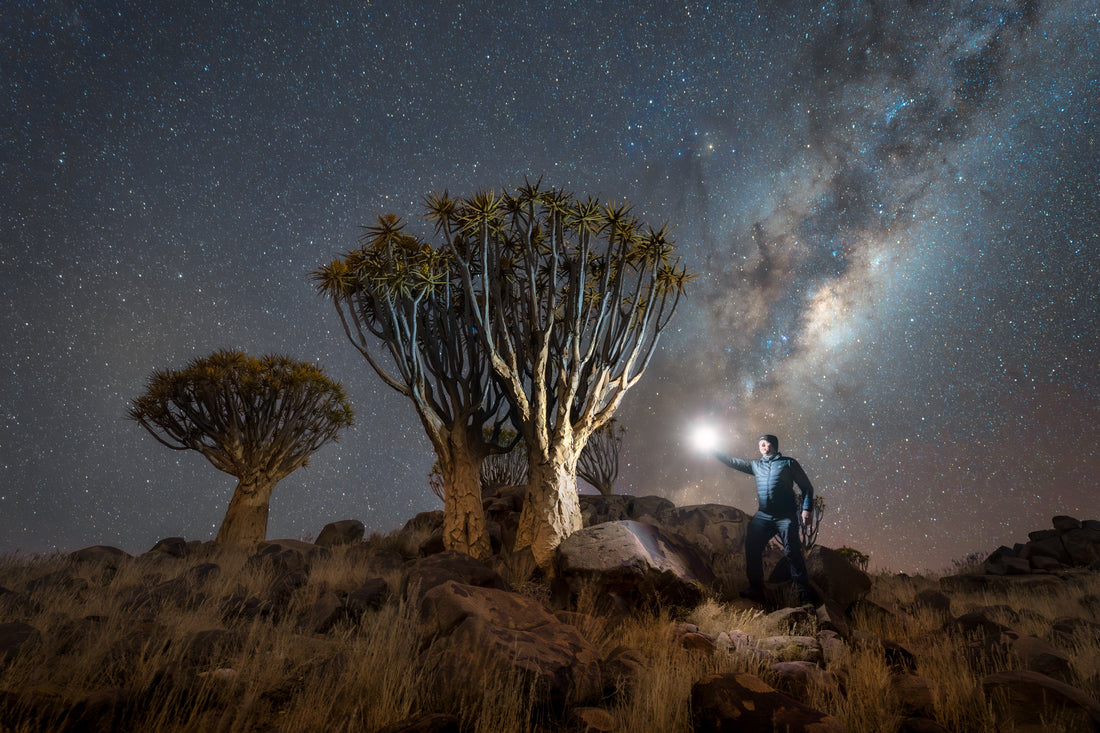
The Southern Namibia Loop: A Photographer’s Perfect 6-Night Itinerary
Kyle GoetschShare

Namibia has a way of getting under your skin. It’s wild and raw, full of space and silence, where the light changes everything and the stars feel close enough to touch. I’ve been fortunate to explore many corners of this country, but there’s one route I keep coming back to. A simple southern loop that covers three of my favourite locations: 1) the quiver tree forests near Keetmanshoop, 2) the dunes of Sossusvlei, and 3) the abandoned ghost towns near Lüderitz.
It’s the kind of trip that gives you everything. Wide landscapes. Night skies. Compressed dune textures. Intimate abstracts inside old buildings. If you spend two nights in each place like I did on this trip, you’ll come home with a solid, diverse portfolio and more than a few memories etched into the sand.
Here’s how I like to do it.
1) Quiver Tree Forests — Sculptures Under the Stars
 The first stop is usually near Keetmanshoop, home to some of the best quiver tree forests in the country. These aren’t actually trees (they’re giant aloe plants), but they feel ancient and mythical, standing tall among the boulders like desert guardians. They’re also perfect foregrounds for astrophotography.
The first stop is usually near Keetmanshoop, home to some of the best quiver tree forests in the country. These aren’t actually trees (they’re giant aloe plants), but they feel ancient and mythical, standing tall among the boulders like desert guardians. They’re also perfect foregrounds for astrophotography.

If you’re after the Milky Way, the best time to be here is between April and September. The core of the galaxy starts to rise nice and vertical in the early mornings, and later in the season it stretches across the sky at an angle that works beautifully with the landscape. I always recommend scouting compositions during the day. Some of the best clusters of trees are tucked away behind koppies or low ridges, and they really come alive at night.

Sunset here is underrated too. As the light softens, the trees glow warm and the rocks throw long shadows, it’s a great time to slow down and look for cleaner frames.
2) Sossusvlei and Deadvlei — Dunes, Light and Long Lenses
 From there, I usually head northwest into the heart of the Namib Desert. Everyone knows the dunes of Sossusvlei, but they still blow me away every time. What makes this place special isn’t just the scale, it’s how the light sculpts the dunes, especially in winter when the air is cooler and the shimmer disappears. That’s when long lens photography comes into its own. You can shoot compressed layers of dune ridges with perfect detail and contrast.
From there, I usually head northwest into the heart of the Namib Desert. Everyone knows the dunes of Sossusvlei, but they still blow me away every time. What makes this place special isn’t just the scale, it’s how the light sculpts the dunes, especially in winter when the air is cooler and the shimmer disappears. That’s when long lens photography comes into its own. You can shoot compressed layers of dune ridges with perfect detail and contrast.


Deadvlei is the obvious highlight. Those ancient camelthorn trees, frozen in time on the white pan, are always worth the early mission. But don’t overlook the less iconic spots. Some of my favourite images from this area have come from quietly wandering the edges, shooting shadows, subtle curves, or isolating shapes as the light shifts.

The morning light here is quick and dramatic. Be ready before the sun hits the sand. By mid-morning, things get harsh and flat. Evenings are softer but trickier for direction, so plan accordingly.

3) Lüderitz and Kolmanskop — Ghost Towns and Sand Stories
 The final stretch of the loop takes you west to Lüderitz and the haunting ruins of Kolmanskop. Once a booming diamond town, it was abandoned in the 1950s and slowly swallowed by the desert. The light, the textures, the quiet. It’s a playground for photographers who enjoy shooting more intimate scenes.
The final stretch of the loop takes you west to Lüderitz and the haunting ruins of Kolmanskop. Once a booming diamond town, it was abandoned in the 1950s and slowly swallowed by the desert. The light, the textures, the quiet. It’s a playground for photographers who enjoy shooting more intimate scenes.

I love the way the sand creeps into every corner of the old buildings. The way the wind reshapes rooms and hallways overnight. The way the colour of the walls catches early light. It’s a place to take your time, to move slowly, and to really watch how the light plays with form.

Winter can bring strong winds, but that’s a blessing. Footprints disappear, the dunes reset, and every morning feels fresh. You will need to get a special photo permit allowing you photograph this area from sunrise to sunset. The light is amazing in the mornings, but a good tip is to go in the afternoons as well. There won't be as many people there and gives you more time to explore before the light gets good.



Final Thoughts
If you’ve got six nights and want a trip that ticks all the boxes, then this is it. Two nights at each location gives you time to settle in, scout properly, adapt to weather, and not feel rushed. All the images in this post came from doing this exact loop and it delivered everything I love about photography. Big landscapes. Clean compressed scenes. Abstracts. Astro. Mood. Story.
Namibia rewards patience and presence. Take your time. Sleep a little less. Let the desert show you what it’s made of.
If this loop speaks to you, keep an eye on my workshops page or reach out for details about future trips. I’d love to show you around.
